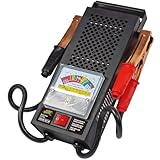Having been a long-time owner of a golf cart and a frequent golfer, I have experienced plenty of battery problems on the course. A dead golf cart smack in the middle of a great round is the most annoying thing. I have discovered over time that maintaining a ride free from problems depends on routinely monitoring your golf cart batteries. I’ll walk you through all you need to know about testing golf cart batteries in this article so you can avoid those annoying situations and maintain your golf cart in great shape.
Understanding Golf Cart Batteries
Golf cart batteries come in a couple different types 6-volt, 8-volt, and 12-volt. Every type has unique traits and testing criteria. Common problems including low capacity, delayed charging, and shortened run time—which can point to a deteriorating battery—also need awareness.
Tools Required for Testing Golf Cart Batteries
Starting golf cart battery testing calls for some basic tools:
- Golf cart battery load tester
- BATTERY TESTING: This handy tool helps you test…
- STARTER AND DEEP CYCLE BATTERIES: Test 12V and 6V…
- SAFETY FEATURES: Rubber insulated carrying handle…
- COMPATIBLE RANGE: The Battery Tester is able to…
- EASY TO USE: Offers accurate battery readings of…
- Versatile Digital Multimeter – Accurately measures…
- Thoughtful Design – Support Data Hold, Large LCD…
- Suitable For Many Occasions – This Multimeter is a…
- Ensure Safety – Double ceramic fuse is anti-burn…
- Additional Tips – Please take off the cap before…
- Voltmeter
- Safety equipment (gloves, goggles)
These instruments will guarantee your batteries’ proper operation and enable you to precisely determine their condition.
Step-by-Step Guide to Testing Golf Cart Batteries
Preparing for the Test
Safety First: Make sure you follow all required safety guidelines before beginning golf cart battery tests. To guard oneself from any possible acid spills or electrical risks, don gloves and eyewear. Verify also that the key is taken off and the golf cart is switched off.
Disconnect the Battery: Disconnect the battery from the golf cart to prevent any problems with the electricity. More accurate test results will also follow from this.
How to Test a Golf Cart Battery with a Multimeter
A multimeter is among the most often used instruments for evaluating golf cart batteries. Here’s how you do it:
- Set the Multimeter: Your multimeter should be set to DC voltage.
- Connect the Multimeter: Attach the positive (red) probe to the battery’s positive terminal and the negative (black) probe to its negative terminal.
- Read the Voltage: A completely charged 6-volt battery should read approximately 6.3 volts; an 8-volt battery should read approximately 8.4 volts; a 12-volt battery should read approximately 12.6 volts. Should the reading be much lower, you may have to replace your battery.
How to Test Golf Cart Batteries with a Voltmeter
Testing golf cart batteries using a voltmeter functions much like using a multimeter:
- Set the Voltmeter: Make sure your voltmeter is DC voltage measuring tool.
- Connect the Voltmeter: Position the negative probe on the negative terminal and the positive probe on the positive terminal.
- Check the Reading: Match the reading to the predicted voltage for your battery type. Low values call for possible battery problems.
Performing a Load Test on Golf Cart Batteries
One additional in-depth approach to monitor battery condition is load testing. Loading test golf cart batteries follows this process:
- Use a Golf Cart Battery Load Tester: Connect the load tester to the battery terminals.
- Apply the Load: Apply a load to the battery using the Load Tester’s directions.
- Monitor the Results: Under load, a good battery should preserve a constant voltage. Significant voltage declines suggest that the battery may need replacement since they point to failure.
How to Test a Golf Cart Battery Charger
Not less crucial than the batteries themselves is your battery charger. Testing a golf cart battery charger follows this approach:
- Check the Output Voltage: Measuring the charger’s output voltage is best done with a multimeter.
- Inspect the Charging Process: Connect the charger to your battery then track the charging process. It could be time for a replacement if the charger isn’t charging the battery completely or is supplying the wrong voltage.
Bestselling Golf Cart Battery Chargers
If you think your charger is the issue I have linked the three bestselling chargers on Amazon below.
- 15 AMP 48 Volt Golf Carts Battery Charger for Club Car 3-Pin Round Plug
- 18 AMP 36 Volt Golf Cart Battery Charger for EZGO TXT with D Style Plug
- 36 Volt Golf Cart Battery Charger for EZGO TXT
- 【15 Amp Rapid Charger/Lead-Acid】 EPOWREY 48…
- 【Dust & Waterproof】 Having the IP67 Protection…
- 【Smart Trickle Charger Technology】 The green…
- 【Lighter Weight and Longer Cable】 With a…
- 【OBC Detection】 Designed to work with…
- 【18 Amp Rapid Charger/Lead-Acid】EPOWREY 18 Amp…
- 【Dust & Waterproof】This golf cart charger has…
- 【Fast Heat Dissipation】Our chargers have high…
- 【5.5 lbs Lightweight & 16ft Cables】With a…
- 【High Quality】The quality certified charger is…
- 48V 15A GOLF CART CHARGER: Built for Club Car cart…
- UPGRADED TRICKLE CHARGING & MAINTENANCE: Our 48V…
- EXTENDED POWER CABLE: Comes with a 16-foot power…
- ROBUST WATERPROOF PROTECTION: Equipped with…
- SMART PROTECTION FEATURES: Offers multiple safety…
How to correctly charge your golf cart batteries?
Longevity and performance of your golf cart depend on proper battery charging. Here are few best practices:
Always make sure you use a charger made especially for your type of golf cart batteries. The batteries could be ruined by an unsuitable charger.
Consult the instructions provided by your battery manufacturer for advised charging times and practices.
Steer clear of overcharging; it could damage batteries. To stop overcharging, use a charger including an automatic shut-off function.
Even if they are not completely drained, charge your batteries following every use. This prolongs their lifetime and helps them to remain in capacity.
Charging batteries produces gasses, hence it is advisable to charge them in a well-ventilated area to prevent gas accumulation.
Failing Golf Cart Battery Signs
Early identification of a failing battery will enable you to solve problems before they leave you stuck on the course:
A failing battery may be indicated if your golf cart is not accelerating as fast as it once could do.
A clear drop in the distance your golf cart can run on a full charge suggests a battery losing capacity.
Longer Charging Times: Should your batteries charge more slowly than usual, this could indicate that their lifespan is nearing conclusion.
Dim lights, either flickering or dim, can mean that your battery is not providing enough power.
Unusual Sounds: Internal battery problems may be indicated by hissing or bubbling sounds during charging.
Environmental Considerations Affecting Golf Cart Batteries
Your golf cart batteries’ performance and lifetime can be much affected by environmental factors:
Extreme temperatures—both hot and cold—may shorten battery lifetime and efficiency. Store batteries in a cool, dry environment to help to offset this effect.
High humidity could cause corrosion of battery terminals and connectors. Clean and check terminals often to stop this.
Correct off-season storage is absolutely vital. Before storing, fully charge the batteries then cut them off from the cart. Periodically check and reenergize them.
How should one safely discard used golf cart batteries?
Environmental safety depends on correct disposal of used golf cart batteries:
Most of golf cart batteries can be recycled. Look for a nearby recycling facility able to handle lead-acid batteries.
Local Rules: Dispose of batteries according local rules. Many places have specialized policies and hazardous material collecting stations.
Some manufacturers and stores have buyback schemes whereby you may return used batteries for a discount on new ones.
Improving Your Golf Cart Batteries
Changing your golf cart batteries will improve running time and performance:
If you require more running between charges, think about switching to greater capacity batteries.
Comparatively to conventional lead-acid batteries, lithium-ion batteries provide shorter lifespan, faster charge times, and less weight. For those looking for best performance, they are a great choice.
Checklist on Battery Maintenance
For regular battery maintenance, a simple checklist might be really helpful:
Weekly chores:
Investigate and tidy battery terminals.
Look at connections and cables for corrosion or wear.
Look at water levels; if necessary, top off with distilled water.
Monthly Activities:
Test each battery for voltage.
Load every battery to assess under pressure performance.
Look at the battery case for damage or cracks.
Give the whole battery compartment great cleaning.
If at all possible, do a comprehensive system inspection under professional direction.
Change any batteries showing notable wear or failure.
Testing Specific Types of Golf Cart Batteries
How to Test 6-Volt Golf Cart Batteries
Though the fundamental procedures are the same as those described above, testing 6-volt golf cart batteries requires close attention to the particular voltage values. Fully charged, a healthy 6-volt battery should read about 6.3 volts.
How to Test 8-Volt Golf Cart Batteries
For 8-volt batteries, make sure your multimeter or voltmeter is set appropriately; then, search for a reading around 8.4 volts when the battery is completely charged.
How to Test a Golf Cart Motor with a 12V Battery
Periodically you might have to test the golf cart motor itself using a 12-volt battery:
- Connect the 12V Battery: Attach the positive terminal of the 12V battery to the motor’s positive terminal and the negative terminal of the motor.
- Monitor the Motor’s Response: Track the motor’s response; if it runs smoothly, most likely it is in good condition. If not, you might have to check into it more or consult a professional.
Common Questions and Troubleshooting
How Do You Test Golf Cart Batteries?
One can test golf cart batteries with a multimeter, voltmeter, or a specialized golf cart battery tester among other instruments. The secret is to guarantee reliable readings and appropriate interpretation of them.
What to Do if Your Battery Fails the Test?
Should your battery fail the test, it could be time for replacement. Verify accuracy of your testing procedure first to be sure. Sometimes testing mistakes or inadequate connections provide erroneous findings.
Maintenance Tips to Extend Battery Life
- Regular Cleaning: Frequent cleaning helps to maintain the battery terminals free from corrosion.
- Proper Charging: Always use the suitable charger and steer clear of overcharging.
- Routine Testing: Frequent battery testing helps you to find problems early on.
In Summary
Maintaining your golf cart batteries’ performance and lifetime depends on routinely testing them. Following the advice in this book will help you to guarantee that your batteries are constantly in perfect condition, therefore lowering the chance of unplanned course breakdowns. Happy golfing; keep in mind that a little upkeep goes a big distance!
FAQs
Could I test the batteries in my golf cart at home? Indeed, you can quickly check your golf cart batteries at home using the correct instruments and safety measures.
In what frequency should I check my golf cart batteries? If your batteries seem to be declining in performance or at least once every few months is advised.
A golf cart battery lasts what length of time? Though this might vary depending on use and upkeep, the typical lifespan is 4–6 years.
Including these measures into your normal maintenance schedule will help to guarantee that your golf cart batteries remain in great condition, thereby enabling your cart to be ready for many rounds to come.
Additional Golf Cart Battery Resources
- How to Replace a Golf Cart Solenoid
- How to Test a Golf Cart Solenoid
- How Many Batteries Does a Golf Cart Take: The Complete Guide
- How Much Are Golf Cart Batteries?
- How Long Does It Take to Charge a Golf Cart: Complete Guide
- How Long Do Golf Cart Batteries Last?
- Golf Cart Battery Water: Complete Maintenance Guide






